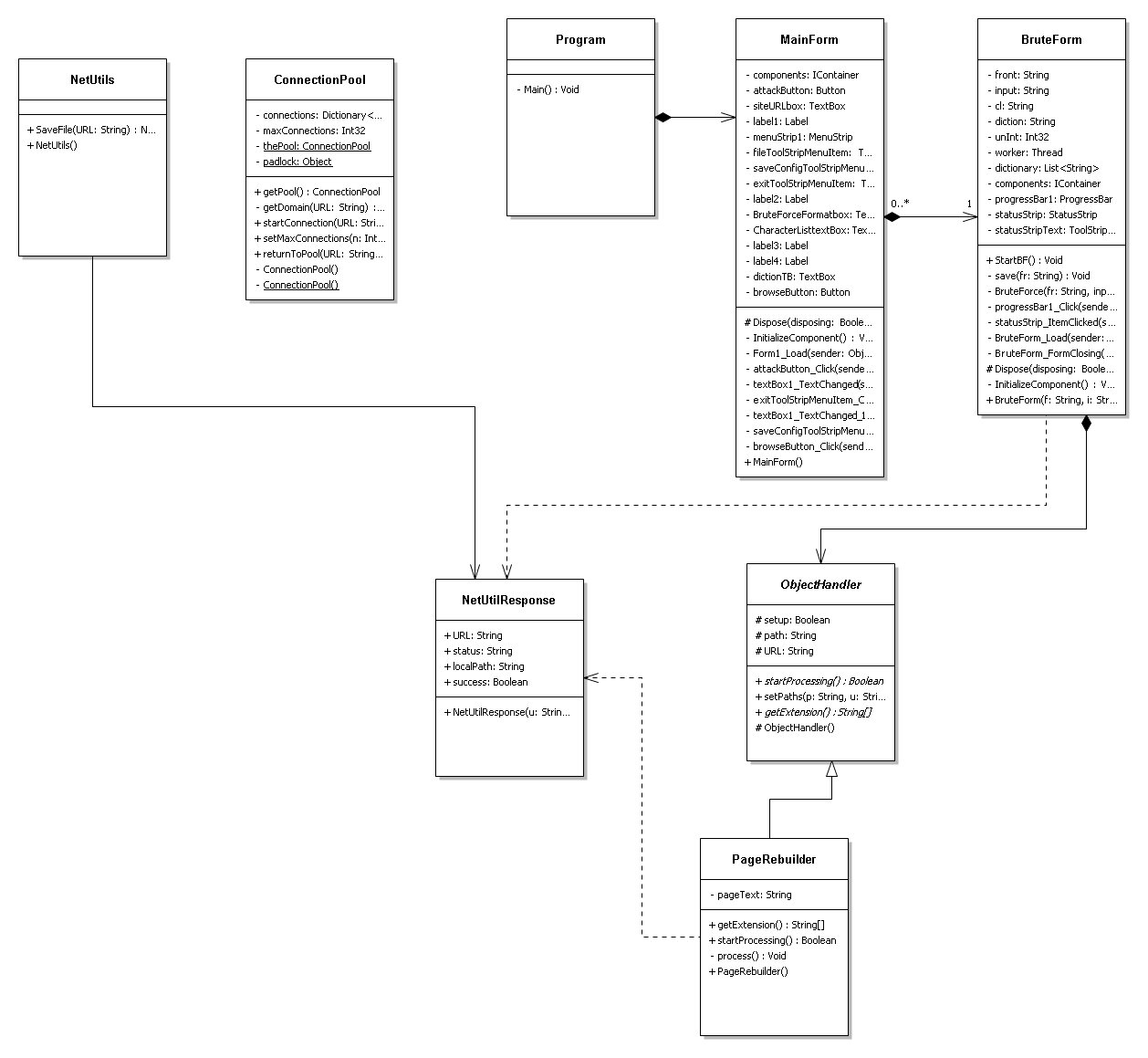AlexsDesignStudy
(→Major Classes) |
(→Major Classes) |
||
| Line 30: | Line 30: | ||
===ConnectionPool=== | ===ConnectionPool=== | ||
The connection pool is a singleton class that maintains the a list of all active connections. The class simply holds a HashMap of strings. When a URL is requested from the ConnectionPool it first trims the URL down to the target domain. This string is then tested against HashMap. If the map does not contain the string it is entered. If it does then the value is checked against the ConnectionPool's maxConnetions member. The method returns true if a connection is allowed and false if it is not. | The connection pool is a singleton class that maintains the a list of all active connections. The class simply holds a HashMap of strings. When a URL is requested from the ConnectionPool it first trims the URL down to the target domain. This string is then tested against HashMap. If the map does not contain the string it is entered. If it does then the value is checked against the ConnectionPool's maxConnetions member. The method returns true if a connection is allowed and false if it is not. | ||
| + | |||
| + | ===ObjectHandlerFactory=== | ||
| + | This class is a singleton class. The object handler factory dynamically creates a ObjectHandler that is best suited to the content it is passed. This is accomplished by using Reflection to find all subclasses of ObjectHandler. Each of these subclasses is then passed the local file address and the URL it came from into the goodProcesser method. If a subclass of ObjectHandler believes it can Handle the content it will return true. The first class to return true is then instantiated and returned to the caller who requested the creation of a handler. Thus the ObjectHandlerFactory completely handles all the reflection tasks required to dynamically build ObjectHandlers.... Is this actually a factory? I think this needs another name ...hmm | ||
Revision as of 12:27, 26 September 2009
Contents |
SiteSearcher
My design study is on a C# application built for the 400 level secure software course. The application scans websites in a brute force manner trying to find common URL components. When a page or object is found it is saved. If the object is an HTML file then it is scanned and dependencies are downloaded onto the local file system. The HTML page is then transformed to link to these local entities. The program can save the state of objects into XML and restore them to their previous state when loaded.
UML Overview
UML goes here
Patterns
To implement this several patterns are used:
- Singleton - This pattern is in the ConnectionPool class. The Connection pool handles a global tally of connections to insure that we do not in inadvertently DoS a website.
- Facade - The NetUtils class is a facade that simplifies the process of dealing with HTTP connections.
- Strategy - The ObjectHandler and all it's subclasses act as a Strategy for dealing with files that are discovered.
Major Classes
NetUtils
This class contains static methods that are common across several classes. These methods are a façade abstracting the System.IO and System.Net libraries to an interface that is specific to HTTP get operations.
NetUtilsResponse
This class is nothing if not a data class. It is created and returned from the NetUtils class. It contains the URL that was accessed, the local path it was saved to, a HTTP status string, and a bool that indicates success or failure.
BruteForm
The brute form contains all the code involved in the parsing of attack strings. The NetUtils class is used to retrieve objects once the URL is determined. Additional processing is preformed by ObjectHandlers which are created dynamically based on the type of file that has been discovered.
Program
This class is a hangover from the default C# template.
ConnectionPool
The connection pool is a singleton class that maintains the a list of all active connections. The class simply holds a HashMap of strings. When a URL is requested from the ConnectionPool it first trims the URL down to the target domain. This string is then tested against HashMap. If the map does not contain the string it is entered. If it does then the value is checked against the ConnectionPool's maxConnetions member. The method returns true if a connection is allowed and false if it is not.
ObjectHandlerFactory
This class is a singleton class. The object handler factory dynamically creates a ObjectHandler that is best suited to the content it is passed. This is accomplished by using Reflection to find all subclasses of ObjectHandler. Each of these subclasses is then passed the local file address and the URL it came from into the goodProcesser method. If a subclass of ObjectHandler believes it can Handle the content it will return true. The first class to return true is then instantiated and returned to the caller who requested the creation of a handler. Thus the ObjectHandlerFactory completely handles all the reflection tasks required to dynamically build ObjectHandlers.... Is this actually a factory? I think this needs another name ...hmm
